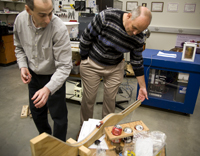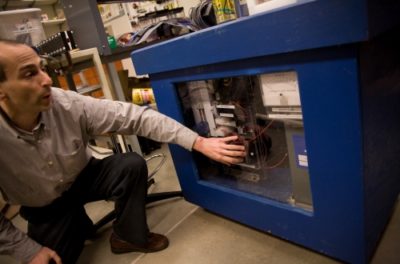Physics class explores basketball, baseball and more
Because physical laws are indisputable – except for Michael Jordan – instructor Michael Kruger tries to portray the friendly nature of physics by teaching it in ways that relate to students’ personal lives.
An undergraduate class that more than 100 College of Arts and Sciences students enroll in each semester, the Physics of Sports provides a basic look at the ways natural law and sports activities intersect. This can include gravity, jumping and bungee cord extensibility. The course also covers technological developments and changes in sports equipment that may affect a game’s outcome.
“Physics is the study of a group of natural laws,” said Kruger, Curator’s Professor of Physics and Department Chair. “Those laws are immutable and affect our lives in ways seen and unseen. They are always present and everywhere.”
Kruger chose the topic and began the search for a textbook, only to discover that none existed. He enlisted the help of Jerzy Wrobel, Professor of Physics and Introductory Lab Supervisor; and now they are ready to submit a proposal for their own book, “The Physics of Sports”.
For every action a person takes, there are always certain laws of physics in effect. While a person might not think about momentum, gravity and friction while engaged in sports, these factors affect the action of a knuckleball or the topspin on a tennis ball.
An undergraduate research opportunity

Professors Michael Kruger and Jerzy Wrobel demonstrate how gravity works by rolling a car on a track. This is just one of many principes tested in the lab.
Students can test scientific principles in a lab crowded with an assortment of tools used in physics: motors, ping pong balls and tiny paratroopers. For instance, some of the plastic paratroopers are burdened with paper clips or other weights to see how that affects their descent, and some have had the drag on their chutes hampered by a few well-placed holes. These experiments represent the same physics behind the strategies sometimes used in sports to take advantage of wind velocity and direction or the arc of an object in flight.
In addition to his teaching and research, Kruger works with the National Federation of State High School Associations, making sure the playing field is level for high school athletes and assuring the integrity of the game. For example, he helps with the regulation of non-wooden bats. Because these bats may improve over time, some players will artificially age their bats to get better results. Major League Baseball has avoided this situation by only allowing wooden bats.
For safety reasons, the condition and stability of equipment are critical factors in both youth and professional sports. Recent articles in the New York Times and the New Yorker deplore the frequency of concussions and other head injuries, citing instances of memory-related diagnoses among pro football players that are five times the average for their age groups. Surprisingly, women’s basketball is the sport with the second highest incident of brain injuries, after football.
Does practice – or study – make perfect?
When asked if athletes could apply themselves and study the physical principles behind certain actions to become better at their sport, Wrobel replied, “A bird could study flying, but the bird would not learn to fly any better. Athletes teach themselves what works by repetitive performance and experimentation. Cal Tech has the longest history of losing in basketball. If one could study and improve athletic performance, those geniuses out there should finish #1 every year.”
Asked about Michael Jordan’s ability to suspend himself in midair, Kruger had a ready explanation.
“He doesn’t. It’s the same illusion we observe when a ballerina is at the top of a grand jeté,” said Kruger. “The position of their arms and legs changes their centers of mass and we see them as suspended in midair.”
That would never happen!
Both professors seize on the numerous laws of physics defied in movies and TV shows and are considering this as the basis for another class.
Time travel, if it works at all, only works one way and that’s forward. Traveling back through time appears impossible. If a person wants to go to the future, he or she should make sure of that decision – it’s permanent.
When Spidey slugged an adversary, the fellow slid rapidly down a long corridor; yet Peter Parker (Spiderman) remained stationary. According to Newton’s Third law, Spidey should have moved backwards when he landed the punch, because for every action, there is an equal and opposite reaction.
Kruger and Wrobel think there’s a book here, too.
Physics at work in sports
- Tennis – Laws of Friction: Topspin is achieved when the player strikes the ball with the racket in such a way as to slide the ball over and up at the same time.
- Archery – Newton’s Third Law: In archery, it seems reasonable that the straightest shooter will hit the bull’s eye more often. Not so. The archer’s paradox is the physical phenomenon that makes it necessary to point the arrow slightly to the side of the target in order to strike the center. Essentially, the arrow flexes or deforms around the shaft (reacts) in response to the snap (action) of the released string.
- Track – Laws of Potential, Kinetic and Elastic Energy: Competitive pole vaulting dates back to the ancient world and has been an Olympic sport for more than 100 years. Since the advent of fiberglass poles, the sport has never been the same. Unlike bamboo or aluminum poles, the fiberglass pole’s flexibility has allowed jumpers to reach greater heights and has resulted in the formation of a “6 meters club” whose members have reached 6 meters – 19 feet and 8¼ inches – or higher.
- Darts – Laws of Gravity: A dart moves along a parabolic curve, descending as it travels the distance to the board.
- Wrestling – Laws of Gravity: Thanks to a lower center of gravity, some smaller wrestlers who keep low to the mat are more stable and therefore more successful. It is more difficult for an opponent to get the necessary leverage to overthrow this wrestler.

